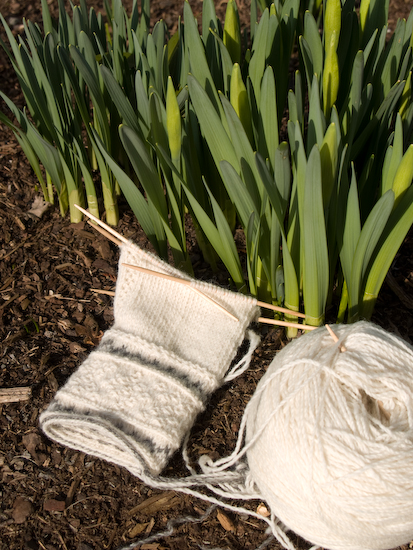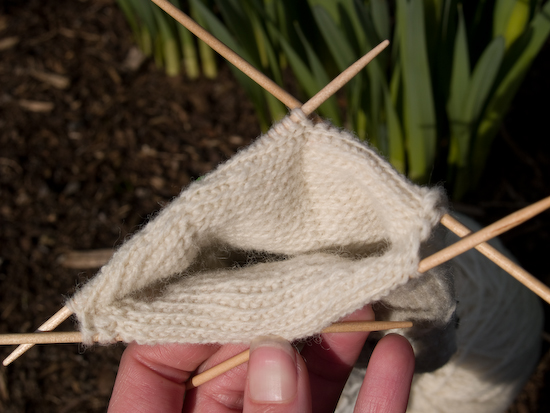Old tricks for new dogs
Everyone who wasn’t at Madrona has surely read about it by now, and any report from me would be less than complete anyway: I went for full-day classes on Saturday and Sunday, but didn’t spend the night at the hotel and missed rubbing elbows with the galaxy of knitterati. But maybe you haven’t seen half an Orsa mitten yet?

This was my Saturday class – Swedish TvÃ¥andsstickning with the estimable Nancy Bush. Now, I have been Nancy’s fangirl since I first cut my teeth on socks. When I heard she was teaching at Madrona, I knew it didn’t matter a lick what she was teaching: I needed to be there. As one of my classmates said, Nancy could have offered a class on chopping mushrooms and we all would have come. In fact, there were no mushrooms in the course summary, and better yet, there were mittens. Anyone who’s been a reader here for long knows I have a well-developed mitten fetish.
Nancy is just as enlightened and patient and down-to-earth as you might imagine, and she is also taller. Picture a towering benevolent queen in sensible neutrals with pockets conveniently located for stowing balls of yarn, radiating a halo of knitterly wisdom through the yarnovers of her exquisite cobweb of an Estonian lace shawl. Add spectacles and an abundance of woolen-spun hair the color of her skirt. I didn’t bring my camera, so that will have to suffice.
She passed out skeins of z-plied yarn from Sweden, which she calls Mora. We spent the first portion of the class winding them by hand with the help of our tablemates, chatting and listening to the history of the TvÃ¥andsstickning technique. (NB: there ought to be a dieresis over the second ‘a’ – I just can’t figure out to type it. But I’m feeling pretty proud of that ‘Ã¥’…. as much as I’m able to hear the subtleties, it’s pronounced tvo-ahnd-stik-ning.) This ancient way of knitting was nearly extinct until a very old mitten with an unusual construction was discovered in a slag heap. What’s so odd, you might say? It looks like a normal stockinet fabric except for some fancy raised stitches on the cuff, right? Check out the inside:

The researchers interviewed some of the oldest knitters in the area, and they remembered seeing this sort of knitting done. You work from both ends of the ball at once, alternating stitches rather than holding them together (TvÃ¥andsstickning translates as “two-end knitting”), and on every stitch you twist the next strand over the old one. If you’re adding a purl round accent, you bring the new strand under the old with every stitch. The decorative stitches are done with one strand in front, purling, and the other behind, knitting. It’s slow going and you have to pause and dangle after every round to untwist your yarn, and it’s essential to use a z-plied yarn rather than a typical s-plied, because the s-plied will twist more and more tightly and make horrible corkscrews. But it produces a very firm, durable fabric that’s entirely practical for a mitten, and I’ve found that practicing lets me establish a pretty good rhythm. And it’s such a pretty, dainty little mitten! I love it unreasonably.
Sunday was Intarsia with Lucy Neatby. I have long feared intarsia, and haven’t bothered to learn because reindeer jumpers make me shudder. So this was an opportunity to push myself in a direction I wouldn’t otherwise go under the tutelage of a master. Lucy is an encyclopedia of clever tricks applicable to any knitting, and I learned a lot of technical tidbits that will serve me well. I also learned to analyze colorwork charts and separate the good ones from the “evil, seductive rubbish,” that “H-shaped bobbins are the spawn of the devil,” and that “you just need to be belt and braces with cotton.” I learned all kinds of ways to cheat and use Swiss darning (duplicate stitch), crochet, and stranded knitting in combination to achieve complicated effects that would make you set your stash on fire and jump out a window if you tried to work them in intarsia. And lastly, I learned that I really am a stranded colorwork kind of girl. I love my Fair Isle and my Estonian socks and my Norwegian mittens and ski sweaters. It brings me joy to see their jolly little floats linking arms across the back of the work. I take pleasure in trapping them pretend, unpretend when they reach too far. I brought home a couple of striking semi-solid skeins of Socks That Rock mediumweight with every intention of plunging into an Armenian-knit hat as soon as may be. So don’t expect to see very much intarsia chez Blue Garter, but I’m glad to have improved myself in learning more about it.
And that’s my Madrona story. I could go on about how I barely restrained myself from bowing down before Stephanie and offering to fetch her coffee, and how I drove thirty minutes in the wrong direction trying to find the house of Mr. Garter’s cousins in Renton, but this post is getting pretty long. I met lovely knitters, I learned as much as I could stuff into my brain, and I can’t wait for next year!

